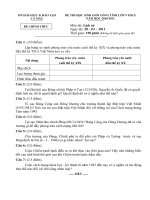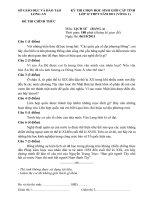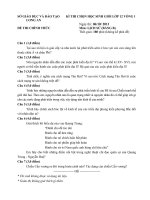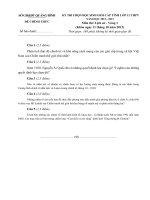Lịch sử 100 năm thông gió nhân tạo - Drager
Bạn đang xem bản rút gọn của tài liệu. Xem và tải ngay bản đầy đủ của tài liệu tại đây (1.49 MB, 113 trang )
It began with the Pulmotor
One Hundred Years of Artificial Ventilation
Ernst Bahns
Dräger. Technology for Life®
It began with the Pulmotor –
One Hundred Years of Artificial Ventilation
Ernst Bahns
6
Table of Contents
One Hundred Years of History
8
Three professionals dedicated to ventilation
10
The History of Ventilation Technology
12
“Zero Hour” in Machine Ventilation: The “Original Pulmotor”
12
The Control Principle of the Original Pulmotor
14
Subsequent Development of the Pulmotor by Bernhard Dräger
16
From Prototype to the Production Line: A New Control Principle
18
The Pulmotor Principle (1)
20
The Pulmotor Principle (2)
22
The Pulmotor Dispute (1)
24
The Pulmotor Dispute (2)
26
Further Development of the Pulmotor: The Pulmotor Canister
28
The Pulmotor in Clinical Applications
30
A New Way: Alternating Pressure Ventilation with the Iron Lung
32
Creativity and Improvisation in the Post-War Period
34
The Beginning of Intensive Care Ventilation: Assistors
36
The Road to Modern Intensive Care Ventilation
38
Constant Progress in Intensive Care Ventilation: From the Spiromat to the EV-A
40
Modern Intensive Care Ventilation: The Evita Series
42
New Markets and New Areas of Application for Ventilation
44
Ventilating Small Patients: The Road to Babylog
46
Intensive Care Ventilation in Neonatal Care: The Babylog 8000
48
From the Pulmotor to the Oxylog
50
The Oxylog Series: The Road to Modern Emergency Ventilation
52
The Role of Medical Staff
54
7
The History of Ventilation
56
The Ventilator in Clinical Applications: An Overview
56
Respiration and Ventilation Technique: The Fundamental Difference
58
Three Problems of Machine Ventilation
60
Pressure-Limited Ventilation with the UV-1
62
New Ventilation Technology with EV-A
64
Simple and Open for Spontaneous Respiration: Pressure Controlled BIPAP
66
®
Optimum Pressure and Open for Spontaneous Respiration: Constant-Volume AutoFlow
68
Pressure-supported Spontaneous Respiration
70
Adaptation of Support to Spontaneous Respiration
72
Regulation of Pressure Support by the Patient
74
Issues with Ventilator Connection
76
Specific Characteristics of Infant and Neonatal Ventilation
78
SmartCare
80
Trends in the Development of the Ventilation Process: Conclusion
82
Tendencies in the Development of the Ventilation Process: The Future
84
From Measuring Instrument to Ventilator Monitor
86
From the Current Situation to a Trend Analysis
88
The Value of Graphic Monitoring
90
Ventilation Monitoring in a New Era
92
Ventilation Diagnostics in a New System
94
Performance and Operation
96
High Performance, Easy to Use – A Contradiction?
98
Standardized Operation – A Vision?
100
From Ventilator to Ventilator Module
102
From Module to Acute Care System
104
Acute Care Seen as a Whole: Infinity Acute Care System
106
Bibliography
108
8
One Hundred Years of History
For Dräger, the history of ventilation is more than a sober
chronological list – the history of ventilation is closely linked
with the history of the Dräger family.
The history of ventilation for the Dräger company starts with
the Pulmotor, for which my great-great-grandfather, Heinrich
Dräger, received the patent in the year 1907. In his memoirs
he describes how on a journey abroad he collected ideas for
resuscitating people poisoned by gas and put these into
practice in the shape of the Pulmotor. It was my greatgrandfather, Bernhard Dräger, who helped prepare his
father’s invention for serial production and developed the
concept of the Pulmotor controlled by airway pressure.
My forefathers must have been committed to ventilation heart
and soul, not simply confining themselves to managing the
company. They participated actively themselves in the
development process. I, too, have inherited this enthusiasm
for ventilation from my ancestors; I am a trained engineer
and from 1999 to 2002 managed the worldwide business
sector for intensive care ventilation. Today’s ventilators are
controlled electronically by microprocessors.
Preface
However, the objective of this brochure is not simply to tell
the history of ventilation, but we also want to contribute to
the discussion about the future of ventilation. We want to
describe ventilation to you in such a way that not only medical
and technical experts will benefit, but everyone with an
interest in the subject can gain an insight and be able to
participate in the discussion about future trends in
ventilation.
Having set ourselves the objective of bringing ventilation
closer to people who do not deal with it on a daily basis,
we have to explain some basics which others with a
grounding in the matter will already know. For simplicity’s
sake, this booklet deals exclusively with ventilation within
the Dräger company.
Stefan Dräger
9
10
Three professionals dedicated to ventilation
The history of ventilation is primarily the history of the people
at Dräger who were involved in it. For many, ventilation was
just about the sum of their life’s work. To represent all those
who contributed with creativity, industry and enthusiasm to
make ventilation at Dräger what it is today we have chosen
three colleagues from the Production, Marketing/Sales and
Development/Construction divisions. Added together, their
years of dedication represent almost a century in the Dräger
family concern.
11
Hugo Hofmeister, born 1939, worked for more than
26 years as a fitter at Dräger. He remembers the
ventilators Spiromat, UV-1 and UV-2 both from
assembling the components and from end production.
He was one of the so-called self-testers in the production
team for the Evita ventilator who carried out the quality
tests on the assembled devices.
Hans-Jürgen Klempau, born 1948, worked for 37 years in
Sales and Marketing for emergency ventilation. He started
his career at Dräger selling the Pulmotor and organized
the very first market launch for an Oxylog ventilator.
During his 10 years as head of the Emergency Medicine
business division he was responsible for worldwide
marketing of the Oxylog ventilators.
Dr. Dieter Weismann, born 1942, started at Dräger as
Project Manager for the development of the EV-A
intensive care ventilator, the start of a career lasting
29 years. As Head of Development he had a decisive
impact on the first two generations of the Evita ventilator.
His contribution to innovation in the field of ventilation is
proved by a dozen patents, primarily in the field of
intensive care ventilation.
12
“Zero Hour” in Machine Ventilation –
The “Original Pulmotor”
Machine ventilation uses mechanical aids and oxygen to support insufficient
spontaneous respiration. A ventilator ventilates the lungs with a ventilation pattern,
a defined period of pressure and volume, thereby creating machine-supported
breathing. Ventilators must be equipped with a control method and generally use
oxygen for ventilation.
Hence two skills were required to develop ventilators. The designers had to know
about control principles and they had to be familiar with pressure gases. Both
prerequisites were fulfilled at the beginning of the last century in the still very
young company of “Heinrich & Bernhard Dräger” and the development of a
ventilator was a top priority in the truest sense of the word.
In his publication “The Development of the Pulmotor” (7) company founder
Heinrich Dräger documented his ideas about developing a ventilator. He described
a new technology for “blowing fresh air or oxygen into the lungs”. His Pulmotor
created positive and negative airway
pressure alternatively and was powered
by oxygen under pressure. In 1907
Heinrich Dräger was awarded the
patent for developing his “original
Pulmotor”.
The original Pulmotor (1907). Protype of the
first Pulmotor that Heinrich Dräger patented
The History of Ventilation Technology
Heinrich Dräger receives his patent from the postman in the presence of his family
13
14
The Control Principle of the Original Pulmotor
To switch between inhalation and exhalation, Heinrich Dräger used a mechanism
in his original Pulmotor that he was very familiar with from his work as a skilled
watchmaker. The ventilation pattern was controlled with a modified movement
with a cam disc.
It is remarkable that Heinrich Dräger
choose this control principle of the
“Original Pulmotor”. He selected a
technical principle which would replace
nature as closely as possible. By setting
the objective of imitating nature for
artificial respiration, he was way ahead
of his time.
For Heinrich Dräger, the physiological
function that needed to be replaced
was the regular movement of the lungs
with a constant time pattern. Therefore he selected a technical principle for his
ventilator, guaranteeing a constant length of inhalation and exhalation during
artificial ventilation. In modern terms, ventilation was time controlled.
Bernhard and Heinrich Dräger
The rest of the world, as well as those who continued to develop the Pulmotor
further, followed another principle. Ventilation patterns were controlled by a
technical principle which switched between inhalation and exhalation when a
certain ventilation pressure was reached. These systems are pressure controlled.
Pressure-controlled ventilation devices became more robust, more reliable and
precise - in short - technically improved. Pressure-controlled ventilation devices seen
from today’s point of view are technically optimized. They followed a path which at
the time was more readily achievable technically.
The History of Ventilation Technology
15
Heinrich Dräger
Here Heinrich Dräger was - ahead of his time. Modern ventilators are not pressure
controlled but are mostly time controlled. However, we do not know whether
Heinrich Dräger knew then that his principle was closer to human physiology than
others. The fact remains that his Pulmotor, patented in 1907, signposted the way
with its timing control.
16
Subsequent Development of the Pulmotor
by Bernhard Dräger
The “Proto-Pulmotor” was certainly a ground-breaking concept but it remained on
the level of a test model that was unsuited for practical use. It had two faults which
Heinrich Dräger recognized and documented during development (7). Firstly his
construction caused considerable re-inhalation of exhaled gas. Secondary the
breathing pattern could not be adapted to the patient due to the inflexible control of
the movement. Heinrich Dräger left it to his son Bernhard and engineer Hans
Schröder to find a remedy for these defects (8).
Bernhard Dräger (1904)
Bernhard Dräger solved the problem of
re-inhalation of exhaled gas by
redesigning the breathing connecting
apparatus. In the “original Pulmotor”
the patient was connected to the
ventilator only by a tube. This tube
worked to a certain extent as an
extension of the windpipe since the
inhalation and exhalation air was only
separated inside the ventilator.
Bernhard Dräger replaced the connecting
apparatus of the “original Pulmotor” with a tube
system consisting of of an inhalation tube and
exhalation tube. By alterating the valve control, the
patient’s inhaled and exhaled air could be
separated thereby greatly reducing the exhaled
carbon dioxide contamination of the inspiratory
air.
Heinrich and Bernhard Dräger
The History of Ventilation Technology
Bernhard Dräger in the test workshop
17
18
From Prototype to the Production Line –
A New Control Principle
Another great challenge in developing the original Pulmotor was the disadvantage
of the rigid control system which could not be adapted to the patients’ lung
function. Dangerous ventilation pressures could arise, which are caused when
the patient’s lungs are deteriorated. Here the engineer Hans Schröder designed a
construction using a control principle which would be used for several generations
of ventilators. The newly designed control mechanism could be switched
automatically from inhalation to exhalation depending on the pressure in the
airways. A detailed description of the functional principle can be found on the
following double page.
The Pulmotor in the medical car of a hospital
on rails (1913)
The answer to the question which
ventilator was actually the first depends
on your point of view. If you define a
ventilator as a machine which provides
mechanically-supported breathing
with a defined time pattern and offers
the possibility of ventilation using
oxygen, then Heinrich Dräger
patented Pulmotor was probably the
first in 1907.
However, if you add the criteria of readiness for
production and proven success in clinical use,
then the development of the Pulmotor by Bernhart
Dräger and Hans Schröder should be considered as
the “first ventilator”. From this point of view the
pressure-controlled Pulmotor was almost certainly
the first ventilator worldwide in the history of
medicine.
The Pulmotor used at a bathing
accident
The History of Ventilation Technology
Serial production of the Pulmotor
19
20
The Pulmotor Principle (1)
The Pulmotor was described in rough detail on the previous pages. Now follows
more detailed description of the structure and function. The technical innovations
of the Pulmotor are the “pressure and suction nozzle” to create the ventilation
pressure and the control mechanism for switching between the inhalation and
exhalation phases.
The energy needed for
machine-supported
ventilation came from the
compressed gas cylinder of
the Pulmotor, oxygen being
not simply medicine for the
patient but also the source of
energy for the ventilator.
Heinrich Dräger’s sketches of the original
The oxygen was mixed with
Pulmotor perational principle (7).
ambient air and fed via a
Left: Inspiration, right: expiration
“suction nozzle” into a tube
system. The construction
of the nozzle can be seen in Heinrich Dräger’s diagram (7). When the compressed
gas was fed in, gas flow was created in the tube system and positive pressure builds
up in front of the nozzle and negative pressure after the nozzle. This type of
construction is called an injector.
A valve system connected the patient during the inhalation phase to the positive
pressure section in the tube system and in the exhalation phase with the negative
pressure section. The approximate airway pressures of the original Pulmotor lay
between +20 mbar in the inhalation phase and -20 mbar in the exhalation phase
(7). The valve system for the original Pulmotor was a four-way cock which was
activated by a movement as described above.
The History of Ventilation Technology
Schematic diagram of the pressure-controlled Pulmotor
21
22
The Pulmotor Principle (2)
In its subsequent development, the injector principle of the original Pulmotor was
retained by Hans Schröder. However, the four-way cock and the movement were
replaced by a new control mechanism. (See the details of the construction in the
diagram on the next page)
Pulmotor with wall bracket
The control mechanism consists of an inflatable
leather bag which is connected to the tube system.
This bag expands under positive pressure and
activates a control mechanism. The control
mechanism in turn activates a valve system which
causes a change to the gas flow in the respiration
system. In the “ON” position the patient is
connected to the positive pressure system and
separated from the negative pressure system. In
the “OFF” position the patient is separated from
the positive pressure system and connected to the
negative pressure system.
The valve system is still constructed such that the tube system is opened to ambient
air during the exhalation phase so gas can flow out freely. A so-called braking
bellows provides mechanical damping when switching between the respiration
phases.
The History of Ventilation Technology
Pulmotor on tripod with additional device to add carbon dioxide to breathing air
for use in the operating theater
23
24
The Pulmotor Dispute (1)
Only five years after the start of production in 1908, 3,000 Pulmotors were in use –
an enormous number at that time (22). Ten years later, the number of Pulmotors
had doubled to almost 6,000 (12) and after 38 years the number was estimated at
more than 12,000 (16). The resuscitations performed with the Pulmotor were
documented with meticulous exactitude by Drägerwerk and published with great
pride in the Dräger magazines (15).
Excerpt from the title page of a
Dräger brochure in 1917
There was a very obvious interest behind this
publicity activity by Dräger. They wanted to prove to
the public that resuscitation via machine-supported
respiration was superior to a manual method.
They defended themselves against criticism of the
principle of high pressure respiration used in the
Pulmotor, a criticism which was levied by clinical
users in the 1920s and came to a climax in the socalled “Pulmotor dispute” (13,14,16).
A Pulmotor, at the time, worked with a ventilation pressure of 20 mm H2O in the
inhalation phase and a negative pressure of -25 mm H2O in the exhalation phase.
To stimulate the respiratory center an admixture of CO2 was used. This meant that,
with the exception of the ventilation pressure in the inhalation phase, ventilation at
the time differed considerably from methods today and the criticism of the clinic is
at least understandable from today’s point of view. But the interesting thing is that
the dispute concentrated mainly on the supposedly
dangerous effects of the ventilation pressure on
heart and lungs – the much more questionable
negative pressures or the CO2 admixture, as we
Excerpt from the title page of
know today, attracted very little interest.
the first edition of the Pulmotor
News from 1929
The History of Ventilation Technology
Use of the Pulmotor at a bathing accident – contemporary drawing from 1913
25









